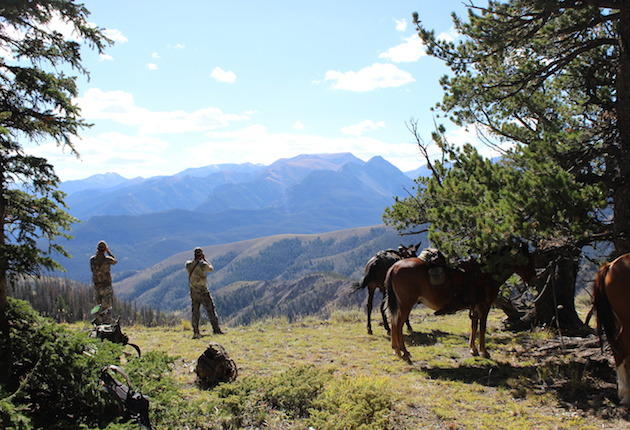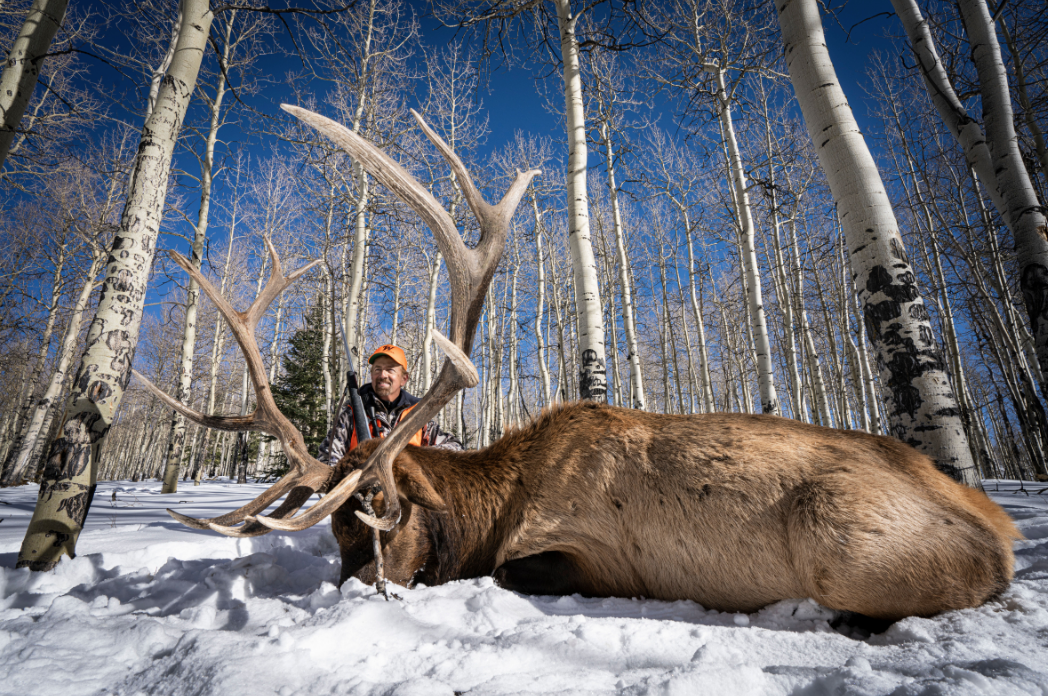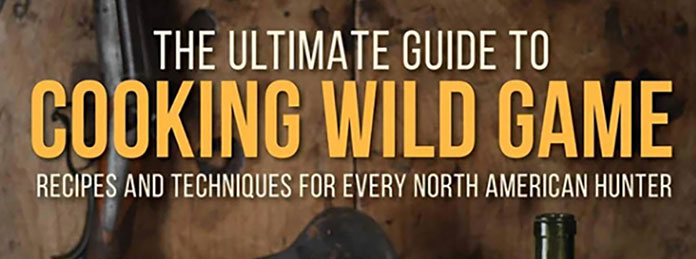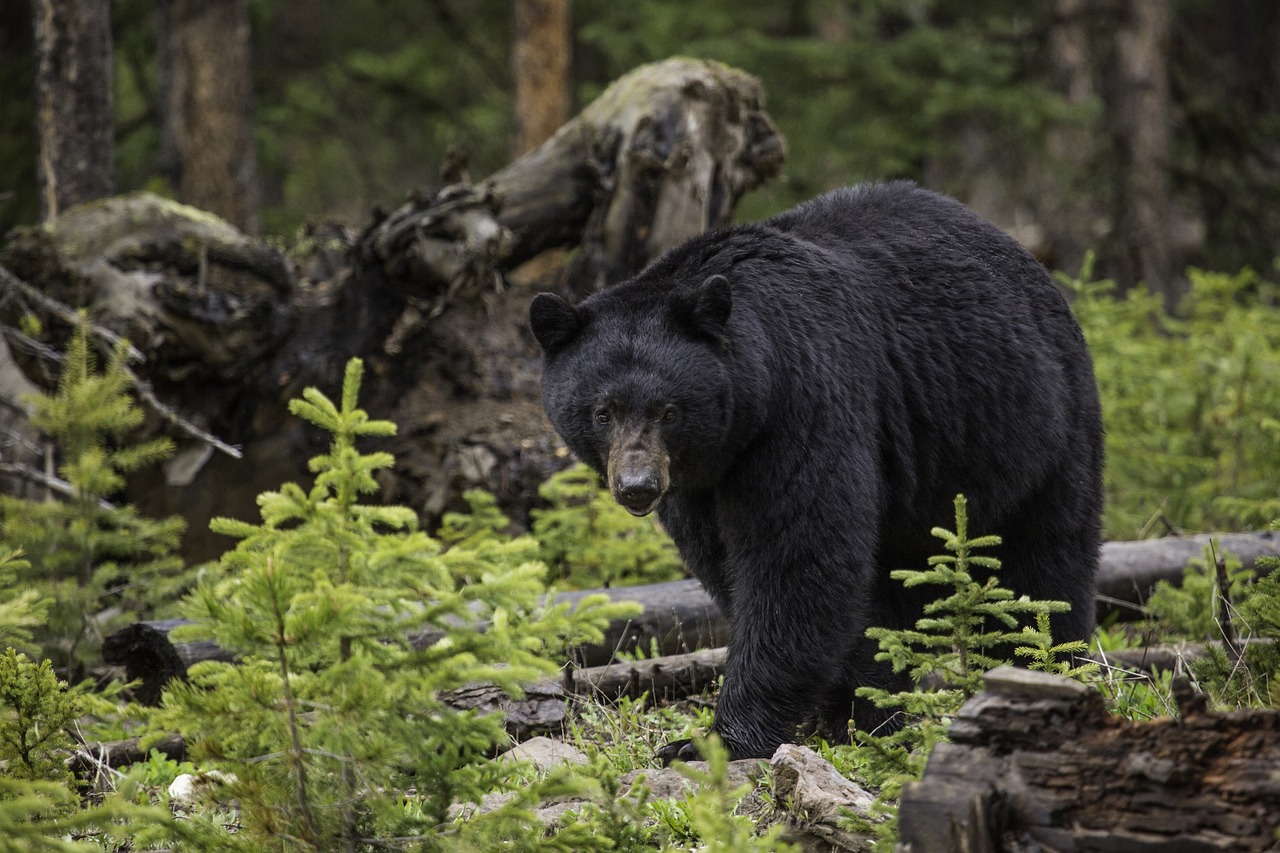“You should be covered up with bugling elk,” the guide predicted. And that’s exactly what happened.
I don’t know what to think when my elk guide orders eggs Benedict for breakfast. We’re at Granny’s in Cody, Wyoming, on the first morning of our bow-hunt, and I struggle to get past the eggs Benedict. A big, rugged guide, a semi-pro linebacker in another life who can break the ankle joints of a bull elk over his knee (I watched him do it) should eat bacon and eggs, a tall stack of flapjacks and drink coffee straight from the pot.
What he said during breakfast, though, was much more compelling.
“We’re hearing lots of bugling bulls. Luck is cheap up there.”
Luck is cheap up there. Yes! I think to myself.
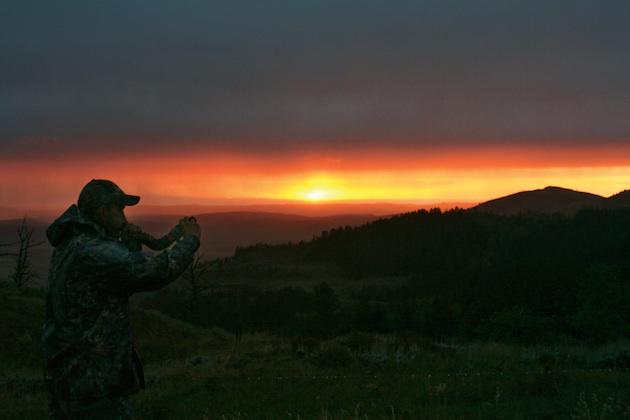
Bugling elk are everywhere as the sun sets in Wyoming.
From Cody, we travel southeast across the Greybull River and through Meeteetse on to our camp in the eastern Absaroka Mountains. There we saddle five horses and ride to a high point to glass. The country is spectacular, aspens glowing gold against deep-emerald spruces and sage fields looking like camouflage cloth draped across the undulating terrain.
Our guides, Dusty Harvey and Phil Quick, bugle and cow-call for an hour, eliciting not one response, so we split up. Dusty and I ride along the crest of the mountain glassing as we go and see bulls and cows in two directions, all feeding peacefully and definitely in play for tomorrow’s hunt.
My sons, Mike and Bobby, leave their horses tied and head back to camp with Phil on foot, hunting along the way. We will circle back, pick up their mounts and meet them at camp, which is hard by the Wood River at 8,000 feet, where a big wall tent with cots and a wood stove provides luxurious accommodations in this secluded wilderness.
Halfway to camp Phil bugles a challenge that is immediately answered by a bull close enough to send both boys scrambling for cover where they will be screened but can still see and shoot.
Phil calls the bull, a five-by-five, to within 25 yards. Mike and Bobby draw but let him pass. Too small and too early.
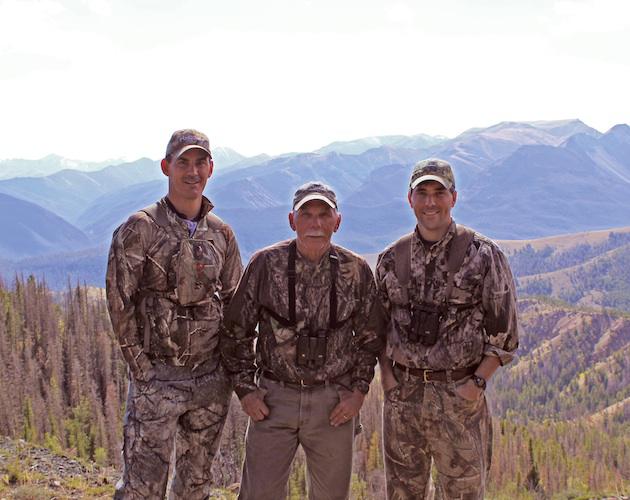
The author with sons Mike (left) and Bobby on their high country elk hunt.
When we drew our tags for Wyoming elk after applying for seven years, the plan was to hunt with rifles on our own. We believed the terrain to be modest and reasonable, readily navigable on foot, but after more thorough investigation we discovered the slopes were steep and difficult. Should one of us get an elk, it would take forever to get the meat out, so Mike contacted Bob Sundeen of Trails West Outfitters and a bargain was struck.
Sundeen said if we arrived a week earlier than was our original plan, bow season would be in and we wouldn’t see another hunter. “You should be covered up with bugling elk,” he said.
That’s exactly what happened.
The following morning our guides decide to leave the horses in camp and we split up again, with Dusty and me in the truck and Phil and the boys on the Ranger four-wheeler.
Here follows perhaps the simplest public-land elk hunt ever. Dusty and I pull up to a green gate, beyond which only foot travel is allowed. We quietly close the truck doors and listen as the cooling engine ticks and settles. The day promises to be bright, crisp, and cold.
Dusty bugles and a bull answers instantly, up high and to our right. This is the first bugle I’ve heard since a Manitoba bear hunt 20 years ago, and it has the same spine-tingling effect now as it did then. Smiling broadly, my guide looks at me and before he can call again, another elk sounds off to our left.
“Come on,” he says as he opens the gate, and we walk perhaps 300 yards before the high and right bull bugles again, only lower now.
“He’s coming, let’s get set up.”
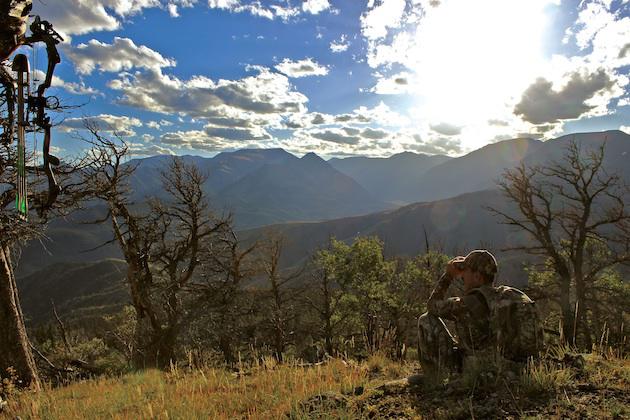
Mike Leonardi glasses a series of meadows on a distant ridge.
We slip through a stand of spruce that opens into a small clearing with a dead snag in its center and where several lanes intersect like spokes of a wheel. Dusty points to a big spruce with classic spreading limbs cascading to the forest floor, and says, “Kneel right there, and get ready. He’ll probably come from the near path or the one beyond it.”
He raises his Zeiss rangefinder binoculars and says, “The dead tree is 19 yards, the far path is 50. Look for legs under the trees, and when you see ’em, draw. I’ll be behind you and to your left.”
Well, that pretty much covers everything, I think to myself, as I disconnect my quiver, nock an arrow and hunker in. Having practiced hard out to 60 yards, I will take a 50-yard shot if the opportunity presents itself. In truth, I can’t believe this is happening. Dusty is cow-calling, mimicking a cow elk desperate for a relationship. A bugling bull is coming in and I am waiting with lethal intent. I’ve killed several deer with my bow — thrilling hunts all, but none like this. I can hear bugles to the left as well, and know from turkey hunting that competition is a good thing.
The near bull bugles so loudly and with such raw intensity the sound fills me to overflowing. Then, legs appear under the trees, striding steadily toward the opening. Still kneeling, I draw my bow and wait. The bull walks clear at 25 yards, stops broadside, turns his head and looks into my soul. I count six points on one side. Good enough for me.
When my 20-yard pin finds the crease behind his shoulder, I touch the release. The sound the arrow makes when it buries home is graphic and unforgettable. He sprints to the edge of the clearing and into the trees, stops on a steep slope and stands there. Through his binoculars Dusty can see blood pouring down the bull’s chest, and I watch, willing him to tip over, but he walks up the slope into the trees and disappears.
I realize I am shaking. Neither Dusty nor I move or speak, both of us listening intently until, after several minutes, we hear a loud crash. A subdued celebration ensues.
“Let’s give him some time,” Dusty says. “I left my rifle at camp, and we should get it before we look for him.”
I cannot disagree with his plan. It’s not uncommon to encounter grizzly bears in this area, with one hunter reportedly seeing 13 in one day.
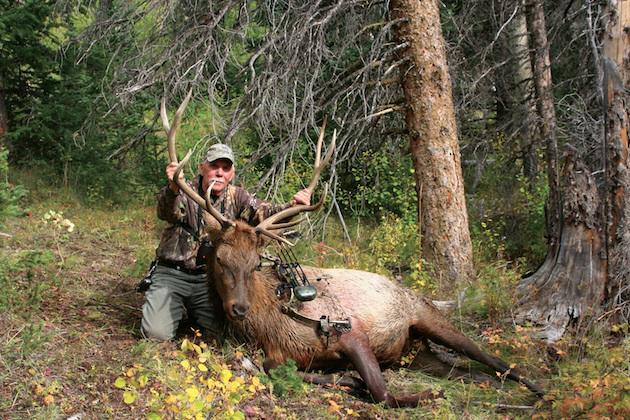
The author and his trophy bull. With the rut in full swing, the mountains echoed to the bulls’ strident bugles.
We head to camp, retrieve the .450 Marlin, and on the way back cross paths with Dan Smith, a Wyoming game warden. As Officer Smith confirms my legitimacy, he asks if we’ve had any luck.
“A six-by-five . . . no monster but a true and earnest bull elk.”
“Any elk with a bow is a trophy,” says Smith. I am gratified to hear him say this, agree with him wholeheartedly and invite him to help us find the animal.
We find good blood where the bull paused, then we follow the trail across a bone pile of dead trees, one of which is freshly snapped in half and bloody. The sign gets thinner, though, and I begin to question my shot, but Dusty and Dan sort things out while I follow, looking ahead.
Finally, there he lies, soaking wet from wallowing and reeking of the rut. He traveled less than 50 yards, and I am thrilled to have him. Luck was cheap this morning for sure.
We begin the process of skinning and quartering the bull with the comforting knowledge that the truck is only 500 yards away and the path is flat as a fritter. Later, we stop at the one spot on the mountain, around 9,500 feet, where our cell phones will work, and Dusty calls Bob Sundeen to report on our hunt. I hear only one side of the conversation.
“Rick killed a big bull this morning,” Dusty says, then pauses, listening, and adds, “six-by-five.” More listening, and then, “yea.”
I know Bob has asked him if I am happy with the bull, and Dusty has responded correctly. Of course I am happy with the bull. I am 66 and don’t know how many more mountain hunts I have in me. I’ve killed a respectable bull on my first ever elk hunt — with a bow. I have to fight the urge to dance a jig and sing the Battle Hymn of the Republic.
That afternoon Dusty heads out in the truck to glass and listen on a solo scouting expedition, while I join Phil and the boys not far from where I killed my bull. We slip quietly up a wooded slope and on finding a likely vantage, Phil deploys his troops and sends out a challenge. Two bulls answer. Bobby and Mike are uphill from us, about 50 yards apart, each with a good view and arrows knocked. I am able to see both of them, and watch them react to the bugling. I don’t know exactly how to describe the feelings I experience. These are my sons, grown men, doctors both, yes, but my boys still and to watch them tighten up and go on point is nothing short of fascinating.
The bull on the left is closing, but the one on the right is retreating uphill, probably ushering cows away from the interlopers below. The left bull steadily approaches, then inexplicably changes course to follow the other uphill.
Dusty, in the meantime, has found a solitary six-by-six in a meadow bugling with great fervor to an empty theatre. He watches as the bull drifts forlornly into the trees. He will save him for later.
Next morning Mike and Phil rise early, and in the dark climb to where the bulls had retreated the evening before. At halfway, they hear bugling above them and circle laterally through the lodgepoles and deadfalls. Reaching the crest, they follow the ridge to its highest point above a steeply pitched sage field and select a spot where through a gap in the trees, Mike has a commanding view of the slope. Phil, having folded into thick brush behind him, cow-calls and a bugle sounds from a bull nearly in their midst. Mike prepares to draw when a spike crosses 25 yards away, bugling as if he were king of the mountain. Only seconds pass before another bull ghosts into view, this one a beautiful six-by-seven a mere ten yards down the slope.
Mike whispers, “Stop him,” hoping Phil will cow-call, but Phil doesn’t hear. The bull does hear him, though, and pauses to look at Mike who turns to stone. When the bull starts to walk Mike draws, and spotting the movement, the bull stops again. The arrow flies true and, mortally wounded, the animal crow-hops, swaps ends, passes Mike and walks out of sight.
Bobby, Dusty, and I are deep in the woods at the foot of the slope, working a bull who is steadily moving away from us, when, over Dusty’s radio we hear Phil whisper, “Hey, Mike has stuck one. Can you guys see a wounded elk side-hilling above you in the sage field?”
We can’t even see the sage field, so we change course and head toward the foot of the mountain, leaving our elk bugling his backside off and moving steadily away. On reaching the toe of the near vertical slope, we see Mike and Phil at the base of a tree halfway to the top. Sheer delight is splashed across Mike’s face as he holds the antlers of a terrific bull elk that quickly succumbed to the effects of the arrow, then rolled downhill to rest against this single, solitary tree. We begin the grueling climb to join them.
Given the bull’s precarious perch, we roll him slowly so Dusty and Phil can remove his head and cape. That done, we slide him downhill to the bottom, where the quartering will be easier.
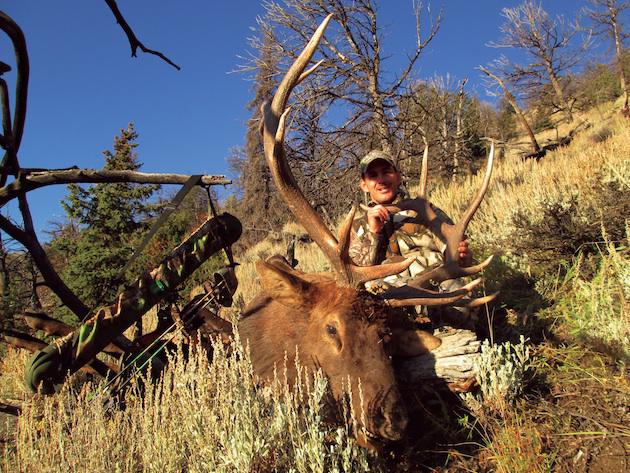
Mike Leonardi and his bull.
We’ve had an amazing run of luck, with bulls bugling everywhere, and three days remaining for Bobby to cash his tag.
The day after I killed my bull, when Bob Sundeen visited camp, I naively said to him, “One down, two to go.” He responded with wisdom born of a lifetime in elk country: “One out of three is pretty darn good. Two would be terrific.”
The following morning Mike and Phil mount a scouting effort, while Dusty, Bobby, and I visit the lonely lothario in the meadow. We wait for half-light, then slip across the clearing to the edge of the trees where Dusty drifts a plaintive cow-call into the cold wind and is answered by a thundering bugle.
The terrain rolls gently here compared to where we’ve been hunting, and the forest is open, offering good visibility. With tension in the air so thick you can clench it in your fists, we move quickly to the base of a low hill, call again, and the bull answers, now closer. Dusty and Bobby find a spot below, but within bow-range of the crest, and I retreat 20 yards or so to watch the action.
The dialogue continues with Dusty cow-calling and the bull responding but hung up somewhere beyond the hill. Then he clams up completely and Dusty’s calls hang unanswered on the slopes.
After 15 minutes of silence Bobby and Dusty rise and engage in a whispered conversation as Bobby secures his arrow in his quiver. I have taken three steps toward them when I see ivory tips rising beyond the crest of the hill 30 yards away, and the bull glides over the top as silently as a puff of smoke. We are busted. Bobby slowly reaches down as the bull burns holes in him, detaches an arrow, and actually knocks it before the beast concludes he doesn’t like the company, turns and trots down the hill.
Running to the top, Bobby kneels near the crest as Dusty bugles for the first time. Though we cannot see the bull, Bobby’s posture and focus are sure signs that we are still in the game.
But it is not to be. The wind betrays us, and the bull needs no more evidence that he should leave the territory.
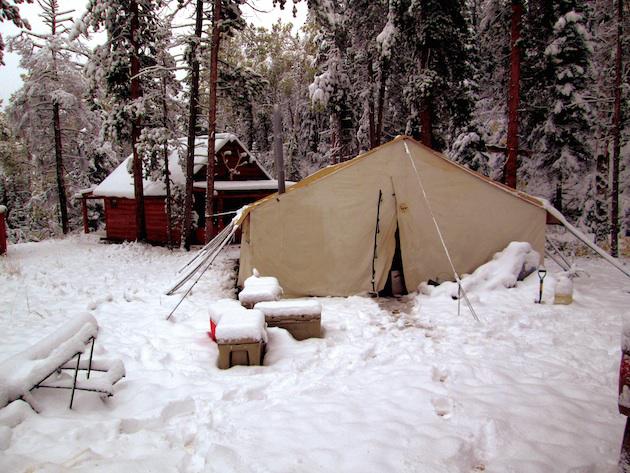
Snow envelopes the camp in the high country.
It is the morning of our next-to-last day and Mike, Phil, and Bobby set out long before sunrise, heading for an area we have not hunted.
They park at a gate on the valley road, where they hear several bulls bugling up high, as if urging the sun to rise so the courting can commence. Wasting no time, the hunters continue on foot, climbing steadily higher, playing the wind, and going straight at the elk under cover of darkness. Finally, they reach tree-line at 9,000 feet, where a steep meadow falls away then rolls up the other side of the mountain. A lone spruce stands sentinel a few yards from the woods, and they crawl out to it as dawn reveals a somber gray sky. It is cold and snow is in the offing.
Phil cow-calls, and down to their right a very good six-by-six emerges from the trees, while another, a six-by-five, enters the meadow across the narrow valley and heads resolutely down to the bottom, bugling all the way. The larger bull, now within 50 yards, stops and watches the smaller one, which has crossed the creek and is steadily closing on the hunters. The six-by-five comes up the slope without pausing, and Bobby has no chance to draw as the beast stops at ten yards and stares hard at them.
Concluding, finally, that he is in a bad place, the bull spins and jumps downhill as Bobby draws his bow. Still rendered mindless by lust, the elk stops and turns to look back as Bobby trips the release. They watch the arrow strike just behind the shoulder, whereupon the bull bolts down the slope, slows to a walk, and finally stops and stands—for a full 30 minutes.
Bobby is unable to take another shot, so the boys study him with their binoculars, looking for blood, expecting him to fall any second. He begins to walk slowly, stopping occasionally, until he goes up and over the far slope.
Mike and Bobby sprint down, swinging wide to scribe a looping circle around the bull and head him off at the base of the far hill. They are seconds late. They reach the bottom, step out on the road and watch him cross 100 yards away.
We search for blood until dark without success while snow falls in big cottony flakes. Next morning we return, the snow now blowing horizontally in a slashing wind. Nothing.
Three months later I call Dusty to discuss the story and ask him if they ever found Bobby’s elk. He tells me a rifle hunter spent a lot of time in that drainage and never saw any sign of the animal.This is what I think, and, yes, what I want to believe. The bull, hit too far forward on a quartering-away shot, suffered a minor wound and survived.
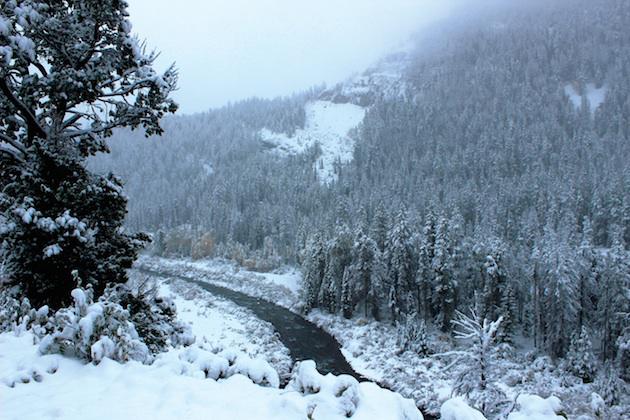
Overnight the Wyoming mountains changed into a stunning spectacle of ice and snow.
As we drive out from camp on our way to Cody and home, the Wood River is a stunning spectacle of ice and snow. Muley bucks lie bedded in the drifts, paying close attention when we slow down to photograph them, while the whitetails, farther out in the meadows, keep to themselves.
We’ve enjoyed a marvelous Wyoming hunt, killing two elk and having our chances at others. Two out of three…not bad according to Bob Sundeen. Terrific in fact.
Editor’s Note: This article originally appeared in the 2015 July/August issue of Sporting Classics.
 An American Elk Retrospective takes readers back through the evolution of elk hunting from the late 1880s up through the 1970s, and is packed with hundreds of amazing vintage photos, historic score charts, records-keeping correspondence, and portraits of award-winning elk. Buy Now
An American Elk Retrospective takes readers back through the evolution of elk hunting from the late 1880s up through the 1970s, and is packed with hundreds of amazing vintage photos, historic score charts, records-keeping correspondence, and portraits of award-winning elk. Buy Now

